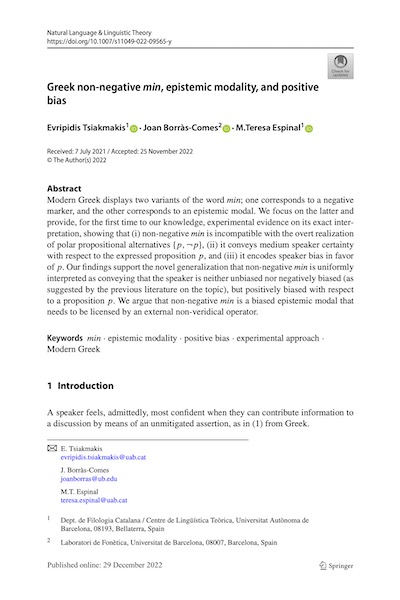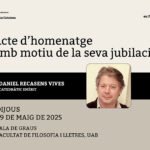29 desembre, 2022

Autors:
Evripidis Tsiakmakis, Joan Borràs-Comes & M.Teresa Espinal
Títol:
Greek non-negative min, epistemic modality, and positive biasEditorial: Natural Language & Linguistic Theory (Springer)
Data de publicació: 29 de desembre del 2022
Text completModern Greek displays two variants of the word min; one corresponds to a negative marker, and the other corresponds to an epistemic modal. We focus on the latter and provide, for the first time to our knowledge, experimental evidence on its exact interpretation, showing that (i) non-negative min is incompatible with the overt realization of polar propositional alternatives {p,¬p}, (ii) it conveys medium speaker certainty with respect to the expressed proposition p, and (iii) it encodes speaker bias in favor of p. Our findings support the novel generalization that non-negative min is uniformly interpreted as conveying that the speaker is neither unbiased nor negatively biased (as suggested by the previous literature on the topic), but positively biased with respect to a proposition p. We argue that non-negative min is a biased epistemic modal that needs to be licensed by an external non-veridical operator.
28 abril, 2025

Autors:
Espinal & Cyrino
Títol:
Experiencers at the syntax-pragmatics interface. The case of the jo ‘I’ – construction in CatalanEditorial: Glossa: a journal of general linguistics
Data de publicació: 18-04-2025
Pàgines: 33 Més informació
Text completThis paper aims to support the thesis that Speech Act related operators have landing sites in syntax, specifically at the syntax-pragmatics interface. In order to attain this goal, it presents the first formal analysis of a construction, dubbed the jo ‘I’ – construction, that shows an overt first person strong pronoun sitting in sentence-initial position of declarative sentences both in pro-drop and partial pro-drop languages of the Romance family. Taking Catalan as a case in point, it is shown that, prosodically, this first person strong pronoun has a particular intonation (a rising pitch accent followed by a high boundary tone). Syntactically, it corresponds not to a subject but to a (kind of) hanging topic that requires a resumptive element in the clause, while semantically it introduces a reference to the speaker who at the time of uttering the sentence is performing a subjective declaration speech act.
26 febrer, 2025

Autors:
Morosi & Espinal
Títol:
Indefinite definites in ItalianEditorial: Natural Language & Linguistic Theory
Data de publicació: 25-02-2025
Pàgines: 38 Més informació
Text completThis paper examines indefinite interpretations associated with morphologically definite articles in Italian, such as Ha comprato {i tulipani / l’olio} (‘She bought (the) tulips / (the) oil’), which allow both a default definite reading and an indefinite interpretation. The paper addresses two main research questions: (i) what grammatical conditions allow indefinite definites in Italian?, and (ii) why do only Italo-Romance varieties, and not other Romance languages, allow the presence of indefinite definites (in addition to bare nouns, the so called “partitive article” and even a bare di)? The primary contribution of the paper is to show that the indefinite reading of definite internal arguments in Italian cannot be derived from a weak definite approach, from kind denotation, or from an operation of derived kind predication. Instead, we argue that internal definite (plural and mass) arguments can be interpreted as conveying an indefinite reading, as long as the event in which they participate denotes incremental homogeneity (Landman and Rothstein 2010, 2012a, 2012b). This hypothesis is supported by the productivity of indefinite definites in habitual (and iterative) contexts, which are incrementally homogeneous by definition; and their compatibility with per ‘for’ (and ogni ‘every’ N) temporal modifiers. Concerning the cross-linguistic and cross-dialectal puzzle, the paper highlights that the use of indefinite definites for the expression of weak indefiniteness reveals the bidirectional influence between dialectal substrata and the national language, giving prominence to the role of competing grammars in speakers of informal Italian.
5 febrer, 2025

Autors:
Real, Espinal & Villalba
Títol:
Vaya in Spanish. From a judgment to a commitment markerEditorial: Journal of Historical Syntax
Data de publicació: 05-02-2025
Pàgines: 26 Més informació
Text completIn this paper we show the diachronic development of Spanish vaya, which goes from a form of the motion verb ir ‘to go’ to an epistemic verbal discourse marker (VDM) associated with the speaker's judgment regarding a proposition (e.g. ¡Vaya! ‘Wow!’ or ¡Vaya que es donoso! ‘How funny you are!’), and then to a VERUM marker (Leonetti & Escandell-Vidal 2009, Gutzmann, Hartmann & Matthewson 2017) encoding the speaker's strong commitment to the truth of a proposition (e.g ¡Vaya si se casa! ‘You bet he's getting married!’). We argue that this shift is a clear case of a run-of-the-mill process of grammaticalization involving three stages and each change corresponds to a different position of vaya in the articulated Speech Act layer advocated by Manfred Krifka (2021). When vaya expresses a subjective epistemic attitude of the speaker, it is postulated in J(udgement)P(hrase), a position associated with epistemicity and evidentiality; when vaya expresses a strong commitment of the speaker to the truth of the proposition it precedes (i.e., a VERUM marker), it is postulated in the higher Com(mitment)P(hrase). All in all, this study argues that the grammaticalization path of vaya is not only unidirectional (against previous analysis like Octavio de Toledo y Huerta 2001 and Company Company 2008), but rather obligatorily implies a bottom-up reanalysis (Roberts & Roussou 2003).
4 juny, 2024

Autors:
Jon Ander Mendia & Maria Teresa Espinal
Títol:
Non-agreeing degree constructionsEditorial: Journal of Linguistics (Cambridge University Press)
Data de publicació: Online: 4 juny 2024
Pàgines: 36 Text completThis paper deals with a construction, which we dub Non-Agreeing Degree (NAD) constructions, with the distinguishing property that the agreement pattern between subjects and degree predicates is optionally disrupted, even in languages (like Spanish) where verbs commonly agree with their subjects. We show that the agreeing versus non-agreeing alternation comes with important semantic differences for the interpretation of the degree construction. We provide a first systematic description of this type of constructions and postulate a formal syntactic and semantic analysis. We argue that NAD constructions are characterized by degree predicates that introduce a non-conventional nominal scale and by subjects that are interpreted as equally non-conventional units of measurement. We postulate an intensionalization process on the subject of NAD constructions, which we capture via a general nominalization function that allows a default as well as an ordinary agreement pattern between subject and copula.









